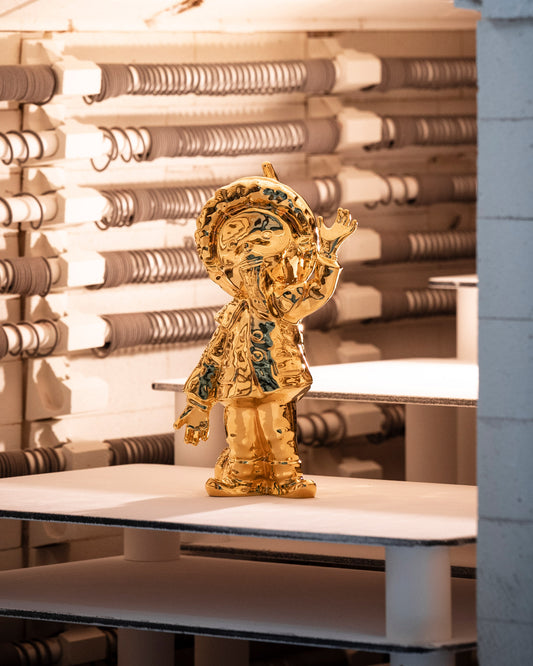THE KPM STAMP AND ITS HISTORY
Some things are simply there. They are so obvious that you have never wondered where they actually come from or what they mean. But they can tell exciting stories. Like our trademark! The cobalt blue scepter has an eventful past...
When Frederick the Great bought the manufactory from Berlin merchant Johann Ernst Gotzkowsky more than 255 years ago, he literally left his mark on the porcelain. Since then, the sceptre mark from the electoral Brandenburg coat of arms can be found on almost all KPM products - at least those that pass the strict quality requirements. If the porcelain piece passes the test after the glow firing, the sceptre is applied to the porcelain with blue underglaze paint. Only then is it glazed and fired a second time, whereby the cobalt color bonds inseparably with the glaze. This not only shows the origin - the porcelain piece is also forgery-proof!
Back to top
A look at the different eras shows that the KPM trademark has often changed. The minor deviations in the early days were mainly due to the apprentices who applied the signet with a brush – of course, not everyone had the same steady hand. And when a wave of imitations began in the mid-19th century, the Prussian eagle was used to remind people of the royal authority. In the meantime, the kingdom is passé and there are trademark laws. By alluding to its original form, the current KPM stamp carries its rich heritage within it – and tells those who ask about it!
The painting marks
Since 1803, decorated porcelain has also been marked with a painting mark. Today, this stamp, in the form of an imperial orb, is usually placed next to the scepter. Depending on the type of decoration, the painting mark is applied in various colors.
Red: A red imperial orb marks the porcelains decorated with floral paintings. However, colored figures and landscape paintings also receive the red stamp.
Green: If porcelain pieces are decorated without floral painting, for example with a gold or platinum border, color decorations or monograms, the imperial orb is stamped in green.
blue: An orb in blue indicates decorations that were made with hot-fire colors. These colors are fired at a very high temperature, sink into the glaze and are dishwasher-safe.
Black: Printed decorations, which KPM sometimes produces in small editions using lithography as a template for ceramic screen printing, are marked with a black imperial orb.
Painter's mark
At KPM, almost all decorations are painted by hand. The porcelain painters can freely interpret the motifs – such as flowers or landscapes – within the specifications of the respective decor. At the end, the painter puts his signature on the foot ring of the porcelain part he has decorated. It identifies the painting as unique. Each painter has his personal signet. In addition, numbers identify the different painting decors. Special decors bear the number 99.
Exceptions
There are also a few exceptions to the above principles. For example, painted MARI vases, small animal figurines and Buddy Bears are not given a painting stamp. Cutlery handles and decorative plates whose underside is not glazed are also only marked with the sceptre. Monograms consisting of flowers also receive the red imperial orb. For aesthetic reasons, spoons receive neither a sceptre nor a painter's mark.


